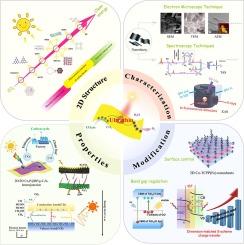当前位置:
X-MOL 学术
›
Prog. Mater. Sci.
›
论文详情
Our official English website, www.x-mol.net, welcomes your
feedback! (Note: you will need to create a separate account there.)
Multiscale structural regulation of Two-Dimensional materials for photocatalytic reduction of CO2
Progress in Materials Science ( IF 33.6 ) Pub Date : 2024-10-05 , DOI: 10.1016/j.pmatsci.2024.101386
Junyan Wu, Lina Zhao, Xu Gao, Yuxin Li
Progress in Materials Science ( IF 33.6 ) Pub Date : 2024-10-05 , DOI: 10.1016/j.pmatsci.2024.101386
Junyan Wu, Lina Zhao, Xu Gao, Yuxin Li

|
The photocatalytic conversion of carbon dioxide (CO2 ) into sustainable fuels and chemicals is a promising method to enhance the natural carbon cycle and combat global warming. This approach involves developing efficient, stable, and cost-effective photocatalysts, with two-dimensional (2D) materials like graphitic carbon nitride (g-C3 N4 ) and hydrotalcite standing out owing to their extensive surface areas and superior charge separation and transfer capabilities. The thinness of these materials shortens carrier transport paths, improves CO2 and water adsorption and activation, lowers energy barriers, and selectively enhances specific reactions. However, focusing solely on thickness might oversimplify the issue, as morphology, edge structures, active site exposure, and interfacial effects also play crucial roles in photocatalytic performance. Adjusting electronic structures through nanoscale parameters like thickness is vital, but a comprehensive consideration of these complex interactions is essential. While previous studies have examined the performance and optimization of 2D materials, in-depth analyses of thickness and structure–activity relationships are lacking, which hinders advanced catalyst design. This review discusses the structural characteristics of various 2D nanomaterials, their role in promoting electron-hole pair separation, rapid electron migration, and effective CO2 adsorption, and also evaluates future prospects of these materials in fuel utilizations and the challenges.
中文翻译:

二维材料光催化还原 CO2 的多尺度结构调控
将二氧化碳 (CO2) 光催化转化为可持续燃料和化学品是增强自然碳循环和对抗全球变暖的一种很有前途的方法。这种方法涉及开发高效、稳定且具有成本效益的光催化剂,石墨氮化碳 (g-C3N4) 和水滑石等二维 (2D) 材料因其广泛的表面积和卓越的电荷分离和转移能力而脱颖而出。这些材料的薄性缩短了载流子运输路径,改善了 CO2 和水的吸附和活化,降低了能垒,并选择性地增强了特异性反应。然而,仅关注厚度可能会使问题过于简单,因为形态、边缘结构、活性位点暴露和界面效应在光催化性能中也起着至关重要的作用。通过厚度等纳米级参数调整电子结构至关重要,但必须全面考虑这些复杂的相互作用。虽然以前的研究已经检查了 2D 材料的性能和优化,但缺乏对厚度和结构-活性关系的深入分析,这阻碍了先进的催化剂设计。本文讨论了各种二维纳米材料的结构特性、它们在促进电子-空穴对分离、快速电子迁移和有效吸附 CO2 方面的作用,并评估了这些材料在燃料利用方面的未来前景和面临的挑战。
更新日期:2024-10-05
中文翻译:

二维材料光催化还原 CO2 的多尺度结构调控
将二氧化碳 (CO2) 光催化转化为可持续燃料和化学品是增强自然碳循环和对抗全球变暖的一种很有前途的方法。这种方法涉及开发高效、稳定且具有成本效益的光催化剂,石墨氮化碳 (g-C3N4) 和水滑石等二维 (2D) 材料因其广泛的表面积和卓越的电荷分离和转移能力而脱颖而出。这些材料的薄性缩短了载流子运输路径,改善了 CO2 和水的吸附和活化,降低了能垒,并选择性地增强了特异性反应。然而,仅关注厚度可能会使问题过于简单,因为形态、边缘结构、活性位点暴露和界面效应在光催化性能中也起着至关重要的作用。通过厚度等纳米级参数调整电子结构至关重要,但必须全面考虑这些复杂的相互作用。虽然以前的研究已经检查了 2D 材料的性能和优化,但缺乏对厚度和结构-活性关系的深入分析,这阻碍了先进的催化剂设计。本文讨论了各种二维纳米材料的结构特性、它们在促进电子-空穴对分离、快速电子迁移和有效吸附 CO2 方面的作用,并评估了这些材料在燃料利用方面的未来前景和面临的挑战。

































 京公网安备 11010802027423号
京公网安备 11010802027423号